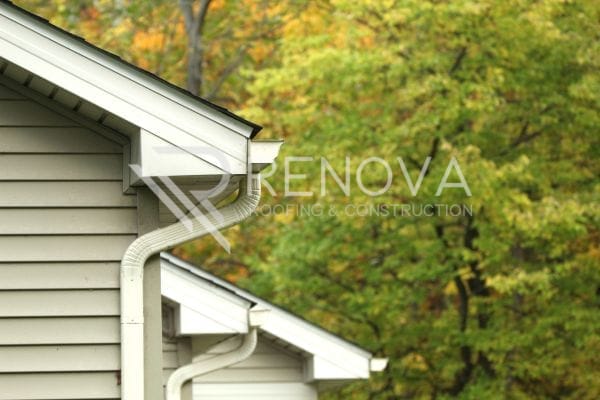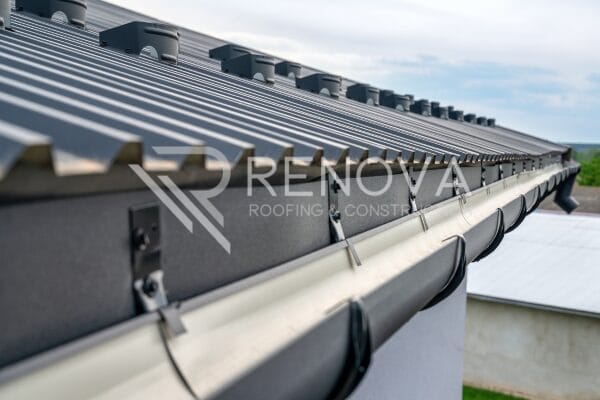You may have heard your roof referenced as the first line of defense for your home. While this is true, it takes a few other components to make the system extremely protective. One of these primary components is your gutters and downspouts.
Homeowners are generally more aware of their gutter systems and not their downspouts. Due to this, we receive a lot of questions regarding what a downspout is, and where to install them on your home. Today we will answer all these questions, along with some crucial tips for maintaining your gutters.
Get To Know Downspouts

A downspout is a vertical pipe that carries rainwater from the horizontal gutter channels down to the ground level. It’s an essential component of a well-functioning roofing system, as it helps to direct water away from the foundation of your home.
Without downspouts, the water collected in your gutters would simply overflow, causing significant water damage to your home’s exterior walls, foundation, and landscaping. This can lead to costly repairs and even structural issues if left unchecked.
In the majority of cases, there are one or two downspouts located at each end of the gutters. However, the amount of downspouts your home needs will depend on several factors, which we will cover in the next section.
How Many Downspouts Do I Need?
As a general guideline, most residential homes typically require at least one downspout for every 40 linear feet. However, this is just a rough estimate, and the actual number may vary significantly based on the specific factors that we discuss below.
Roof Size:
This goes without saying that the larger the surface area of your roof, the more rainwater will be collected in your gutters when there are heavy rains.
A small, single-story home with a basic gable roof design may only need a few downspouts. On the other hand, a sprawling multi-story home with multiple roof sections and valleys will require significantly more downspouts to manage the increased volume of water. Essentially, the more square footage of the roof, the greater the need for additional downspouts to ensure that rainwater does not overflow the gutter channels and cause leaks.
Rainfall Intensity:

Different geographic regions experience varying levels of rainfall intensity and frequency. If you live in relatively drier states that do not receive regular rainfall, such as Arizona, then one downspout will work just fine.
However, if you live in an area prone to heavy downpours or frequent thunderstorms, like homes located in the Gulf Coast region, then this may be a concern you have that can only be resolved through incorporating more downspouts into your gutter system.
Gutter System Layout:
The way your gutters are set up and arranged is important to deciding where and how many downspouts to put in.
Factors like the slope of your roof, the presence of valleys or dormers, and the overall length and complexity of your gutter runs will affect how water flows and accumulates. A well-designed gutter system with strategic downspout placement can effectively manage water flow, while a poorly planned system may require additional downspouts to prevent backups and overflows.

Calculating the Ideal Number of Downspouts
To determine exactly how many downspouts you need to install on your home, you can follow these steps:
Measure the total linear footage of your gutter system by, starting at one end of your gutters with a measuring tape. Walk along the path of the gutter system, measuring each straight section.
Divide the total footage by 40 to get an initial estimate of the number of downspouts needed. Most single-story homes have a gutter system with a linear footage of 100 to 150 feet so you will most likely only need 2 to 3 downspouts.
Don’t forget to consult local building codes and regulations too as some municipalities have specific requirements for the number and placement of downspouts.
Downspout Extensions and Splash Blocks: What Are They and Are They Worth It?
In addition to the gutter downspouts, you may often hear of components known as “downspout extensions” or “splash blocks”. Both these additional gutter components can help your overall roof guttering system and further aid in directing water away from your home’s foundation.
Downspout extensions are horizontal pipes or flexible tubes that extend several feet away from the base of the downspout, carrying water even further away from your home’s foundation.
Splash blocks are simple concrete or plastic troughs placed at the bottom of the downspout. They help to disperse the water flow and prevent erosion around the foundation.
These additions may be especially important if your home is located on a slope or if the soil around your foundation is prone to erosion.
What Should Be The Size Of A Downspout?
Apart from the number of downspouts, the size of each downspout is also important. The size of these will depend on the size of your gutter systems. The average size for gutter channels stands at around 5 or 6 inches. So according to this size, your downspout size needs to be around 3 to 4 inches in diameter.
While rare, remember that if you increase the size of your gutter channels from 6 inches, you’ll want to increase the size of your downspouts to ensure it can handle the excess water.
Maintaining Your Gutters And Downspouts
You will need to maintain your gutters and downspouts regularly to ensure proper water drainage and prevent potential damage to your home. Proper maintenance will extend the lifespan of your gutter system and save you money in the long run by helping you avoid costly repairs or replacements.
Here are some tips:
Regularly clean both your gutters and downspouts at least twice a year, especially after a windstorm, as the debris tends to accumulate in the gutter sections.
It can be a bit difficult to clean your downspouts, but luckily, there are some great tools out there that can help. You can use a gutter cleaning kit available in various hardware stores or use a gutter scoop.
If you don’t feel comfortable cleaning your gutters and downspouts yourself you can also hire a professional to do it for you. They have the tools and expertise to get the job done quickly and safely.
The Importance of Proper Downspout Installation
In this blog post, we discussed what a downspout is and how many downspouts you will need. However, apart from these two things, the other most important component involves taking special care of their installation.
While downspouts may seem like a simple addition to your roofing system, incorrectly installed downspouts can cause serious problems, such as:
- Water pooling around your home’s foundation leading to cracks and potential flooding in basements or crawl spaces
- Erosion of soil around the foundation, compromising the structural integrity of your home
- Damage to landscaping due to excessive water flow in one area
- Increased risk of mold and mildew growth in areas with poor water drainage
This is why we stress the idea of hiring an experienced roofer to ensure that your downspouts are installed correctly and positioned in the right locations to divert water away from your home effectively.
Your Premier Roofing Company Serving The Gulf Coast!
If you are also looking to replace your gutter system or want to install new downspouts, look no further than the team of Renova Roofing & Construction. We are a premier roofing company serving areas across the Gulf Coast.
We install the best seamless gutters that are sure to withstand heavy rains and storms, so contact us today at (601) 647-3433 to learn more about how we can help you.

